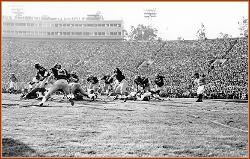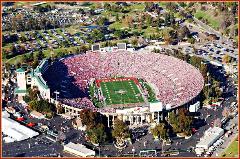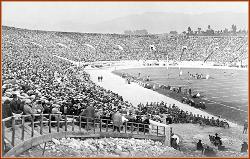






Lambeau Field is the home stadium of the NFL's Green Bay Packers. Originally opened in 1957 as City Stadium, it replaced Green Bay's original
City Stadium as the Packers' home field. For that reason, it was also informally known as New City Stadium until 1965, when it was renamed for
Packers founder E.L. (Curly) Lambeau following his death.
Lambeau Field was the first stadium built for the exclusive use of an NFL team, and is the longest continuously-occupied stadium in the NFL.
Construction
In 1955, the other owners in the league had threatened to force a move to Milwaukee if the stadium conditions in Green Bay were not improved.
In 1956, Green Bay voters responded by approving (70.3%) a bond issue to finance the new stadium. The original cost in 1957 was $960,000
(paid off in 1978) and its seating capacity was 32,500.
The site, bordered on three sides by the village of Ashwaubenon, was selected because it had a natural slope, ideal for creating the bowl shape.
The outdoor practice fields (Clarke Hinkle Field and Ray Nitschke Field) and Don Hutson Center are all in Ashwaubenon, as was The Packers
Hall of Fame until 2003.
The new City Stadium was officially opened on September 29, 1957, as the Packers beat the Bears 21-17. In a ceremony before the game, the
stadium was dedicated by then-Vice President Richard Nixon.
Although they now had a modern facility, the Packers continued their tradition (1934-1994) of playing two or three regular-season games a year
at County Stadium in Milwaukee, 120 miles to the south. Beginning in 1995, regular season games were no longer scheduled in Milwaukee and
Lambeau Field became their only home field. Former Milwaukee ticket holders receive tickets to a preseason game and games 2 and 5 of the
regular season home schedule, in what is referred to as the "Gold package". Green Bay season ticket holders receive tickets to the remaining
home games as part of their "Green package."
Expansion (1961 - 1995)
Demand for tickets at the new stadium easily outstripped supply. In 1961, four years after it opened, the stadium's capacity was increased to
38,669.
Since then, the Packers have been regularly increasing the size of the seating area to accommodate more fans. The bowl was increased to
42,327 in 1963, to 50,852 in 1965 and to 56,263 in 1970, when the stadium was fully enclosed for the first time as the various stands were joined
into one continuous oval around the field.
Construction of 72 private boxes in 1985 increased the seating capacity to 56,926, and a 1990 addition of 36 additional boxes and 1,920
theatre-style club seats brought the number to 59,543. In 1995, a $4.7-million project put 90 more private boxes in the previously open north end
zone, for the first time giving the stadium the feel of a complete bowl and upping capacity to 60,890.
Renovation (2003)
By the end of the 1990s, the Packers believed that they needed a more modern facility to remain financially competitive in the NFL. Rather than
build a new stadium, Chairman/CEO Bob Harlan and President/COO John Jones unveiled a plan to renovate Lambeau Field in January of 2000.
The renovations were to be partially funded by the team, and partially by a 0.5% sales tax in Brown County. Their plan won voter approval in
September 2000, and construction began early the following year.
This massive $295 million reconstruction was designed to update the facilities and add more premium and suite seating, while preserving the
seating bowl and keeping the storied natural grass playing field of the "frozen tundra." The renovation project was completed in 2003, leaving the
current capacity at 72,922.
Lambeau Field has been occupied by the Packers longer than any other NFL team has occupied its own current stadium. In 2006, the Packers
completed their 50th year at Lambeau, tying the all-time NFL occupancy record set by the Chicago Bears at Wrigley Field (1921-1970). (Soldier
Field in Chicago has been the site of a football stadium longer, but was not the home of the Bears until 1971.) In 2007, barring an unexpected
event, the Packers will begin their NFL record 51st season at the stadium.
Although the capacity has more than doubled since Lambeau Field was opened, demand for tickets remains high - season tickets have been
sold out since 1960, and more than 71,500 names remain on the waiting list.







